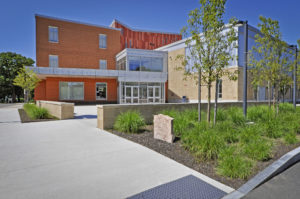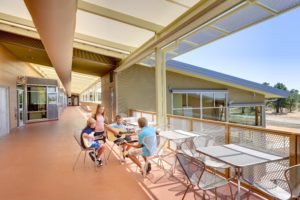State Policies & Programs School & District Leadership Research & Tools
This section highlights state policies and national programs working toward zero energy schools; districts pursuing zero energy and the strategies they use to achieve this target; feasibility studies, assessment strategies, and other technical looks at zero energy school design; and case studies of successful zero energy school buildings.
Schools represent the ideal building type to lead the market shift toward zero energy buildings. Currently, schools make up the third largest subsector of commercial building energy usage. Many schools face growing populations, aging buildings, constrained operating budgets, and increasing energy bills. The cost of energy is one of few budget items schools can reduce without negatively affecting student learning. A zero energy school presents the opportunity for environmental, economic, and educational benefits including improved indoor air quality, higher attendance rates and teacher retention, valuable educational opportunities, lower maintenance costs, and more stable budgets.
RESEARCH & TOOLS
Zero Energy Schools Charrette Toolkit
NBI’s toolkit for schools provides you with materials to help plan and lead a successful charrette for your school project. It can be used for almost any team aiming for high levels of energy efficiency or sustainability whether actively pursuing zero energy (ZE) or not. The toolkit lays out a step-by-step process, starting with pre-charrette planning through post-charrette actions and includes information specifically for a ZE building.
Zero Energy Schools Stakeholder Messaging Guide
This document is a companion piece to the Zero Energy Integrated Design Toolkit for Schools and provides overarching messaging with supporting facts, and identifies key stakeholders and drivers. Effective communication revolves around understanding the drivers that motivate decisions made by each stakeholder. In the school market, student educational outcomes are the primary driver of stakeholders. Framing messages with this driver in mind is key to communicating with them on a level that they understand and that motivates them.
Zero Energy Buildings Resource HUB
The Zero Energy Buildings Resource Hub is a project of the National Renewable Energy Laboratory and the U.S. Department of Energy. It provides resources — many of which are school-specific — on the pathway to zero energy, technologies to help achieve zero energy, building case studies, and programs available.
Advanced Energy Design Guide for K-12 Schools Pursuing ZE:
This design guide is for K-12 school buildings, and applies to all sizes and classifications (elementary, middle, high). Space types covered include administrative and office space, classrooms, hallways, restrooms, gymnasiums and multipurpose rooms, libraries, and food preparation and dining areas. The Guide establishes a set of energy performance goals for achieving zero energy. The goals are provided for all ASHRAE climate zones, in both site and source energy. Strategies on how to achieve these energy targets are provided throughout the guide.
Advanced Energy Retrofit Guide for K-12 Schools
The Advanced Energy Retrofit Guide for K-12 Schools is one of five retrofit guides commissioned by the U.S. Department of Energy. By presenting general project planning guidance as well as more detailed descriptions and financial payback metrics for the most important and relevant energy efficiency measures, the guides provide a practical roadmap for effectively planning and implementing performance improvements in existing buildings. The K-12 Schools guide provides convenient and practical guidance for making cost-effective energy efficiency improvements in public, private, and parochial schools.
Technical Feasibility Study for Zero Energy K-12 Schools
This technical feasibility study provides documentation and research results supporting a possible set of strategies to achieve source zero energy K-12 school buildings. The key barrier that this work addresses is the perception that zero energy K-12 schools are not technically achievable today because the technologies are not available and the design teams lack knowledge to implement them. The study uses typical construction practices and equipment to develop affordable solutions to the challenges of designing a zero energy school. The case studies and industry review provide evidence that the suggested solutions are technically viable and could be employed today at a reasonable cost.
Driving Market Adaptation of Zero Energy Schools
This paper documents the information used to examine the technical resources required; the methods needed to move these technical resources to school decision makers; and the recognition, certification programs, and campaigns that will be a catalyst to move to zero net energy (ZNE) schools. The goals of these strategies is to provide the right information and motivation to decision makers so that ZNE schools become routine in the built environment. The paper prioritizes the key areas to ensure market uptake of ZNE schools.
School Building Assessment Methods
The School Building Assessment Manual is a guide for communities anticipating the expansion of existing or construction of new school facilities. It is a collection of survey and discussion tools that will encourage school administrators, teachers, students, and parents to discover and reflect upon the physical features of school buildings. The intent of the manual is to identify what works and what does not work in K-12 school buildings.
School Regenerative Roadmap Net Zero Schools
This roadmap is designed for school district board members, administrators and facilities staff, funders, architects, engineers, builders, teachers, parents, students, and other K-12 stakeholders. It provides reasons why schools are one of the most promising building types for zero energy, and tips on how to incorporate zero energy concepts in a school design and operation.
Zero Energy Schools – Beyond Platinum
One of the fastest growing trends in school design is zero energy. This article examines the zero energy trend and looks at some of the exemplary projects targeting zero energy. It outlines the basics of sustainable design which are necessary to reach this goal without over-reliance on renewable energy.
Net Zero Schools Report
 This report presents case studies on 15 zero energy schools in the U.S. and was prepared for Baltimore City Schools for use as it developed its 21st Century Building Plan. Research consisted of internet research and phone interviews with school representatives. All of the projects investigated incorporate passive design and time-honored concepts that have been consistently used to provide greater comfort in buildings, as well as state of the art technologies to control lighting and HVAC systems. Overall, the schools used similar technologies, though some technologies were specific to certain climate regions.
This report presents case studies on 15 zero energy schools in the U.S. and was prepared for Baltimore City Schools for use as it developed its 21st Century Building Plan. Research consisted of internet research and phone interviews with school representatives. All of the projects investigated incorporate passive design and time-honored concepts that have been consistently used to provide greater comfort in buildings, as well as state of the art technologies to control lighting and HVAC systems. Overall, the schools used similar technologies, though some technologies were specific to certain climate regions.
4 Reasons Net-Zero Energy Should Start with Schools
Each year, K–12 schools spend more than $8 billion on energy — more than they spend on computers and textbooks combined. Too commonly overlooked is the opportunity to cost-effectively improve the nation’s schools and enhance student performance by tackling the performance of the buildings. The majority of school facilities fail to meet basic occupant needs and fall short of meeting evolving education demands. This article reviews four benefits of zero energy schools which extend beyond energy cost savings.
Towards Net Zero Energy Schools – A Case Study Approach
A part of the zero energy movement garnering the most attention in the construction industry is K-12 public school construction. Alachua County’s Meadowbrook Elementary School (K-5) is a high performance school which can achieve zero energy status with some proven and effective practices. This paper discusses and compares the current baseline energy usage of the school since its completion and target opportunities to reduce energy usage. Recommendations based on the ASHRAE Advanced Energy Design Guide (50% Energy Savings) with the help of energy modelling and simulation would close the gap needed to make Florida schools energy self-sufficient. Further renewable energy production will be added by taking advantage of the Florida climate zone. The suggestions reviewed and applied in this paper will establish guidelines for prospective zero energy schools in general and the Florida based schools in particular.
State of Montana, K-12 Public Schools, Facility Condition Assessment
The State of Montana funded a condition and needs assessment and energy audit of K-12 public school facilities within Montana. In total, 2200 buildings were evaluated by field inspectors. Information on facility condition, educational characteristics, and technology infrastructure was collected. This data were compared with existing standards, and facility improvement priorities were formed.
Submetering of Building Energy & Water Usage: Analysis and Recommendations of the Subcommittee on Buildings Technology Research & Development
This report presents the Subcommittee on Buildings Technology Research & Development’s (BTRD’s) guidance and recommendations on the benefits and complexities in the use of submetering technologies for new and existing buildings. Proven demonstrations of new building technologies are essential to high-performance and sustainable building designs and operational practices.  A promising avenue for advancement of these goals involves the deployment of advanced building instrumentation and submetering for real-time measurement of energy and water usage. This report documents the current state of submetering, relevant case studies, preliminary findings relating to submetering system costs and return on investment, and references to relevant publications for continual and accurate measurement of resource consumption, focused design and retrofit strategies, improved building management procedures, and changes in human behaviors that lead to significant reductions in energy and water usage.
A promising avenue for advancement of these goals involves the deployment of advanced building instrumentation and submetering for real-time measurement of energy and water usage. This report documents the current state of submetering, relevant case studies, preliminary findings relating to submetering system costs and return on investment, and references to relevant publications for continual and accurate measurement of resource consumption, focused design and retrofit strategies, improved building management procedures, and changes in human behaviors that lead to significant reductions in energy and water usage.
Zero Energy Schools Case Studies
Because zero energy buildings are new to most stakeholders involved in the design of a zero energy school, case studies are particularly important. They can help give designers and representatives from the school and community inspiration, ideas and strategies for design and construction. They can also help communicate the value of zero energy design for this building type. The Getting to Zero Forum’s schools case studies page links to narratives of some of the leading zero energy schools projects in North America. These case studies provide valuable lessons learned by those involved in zero energy schools projects.
